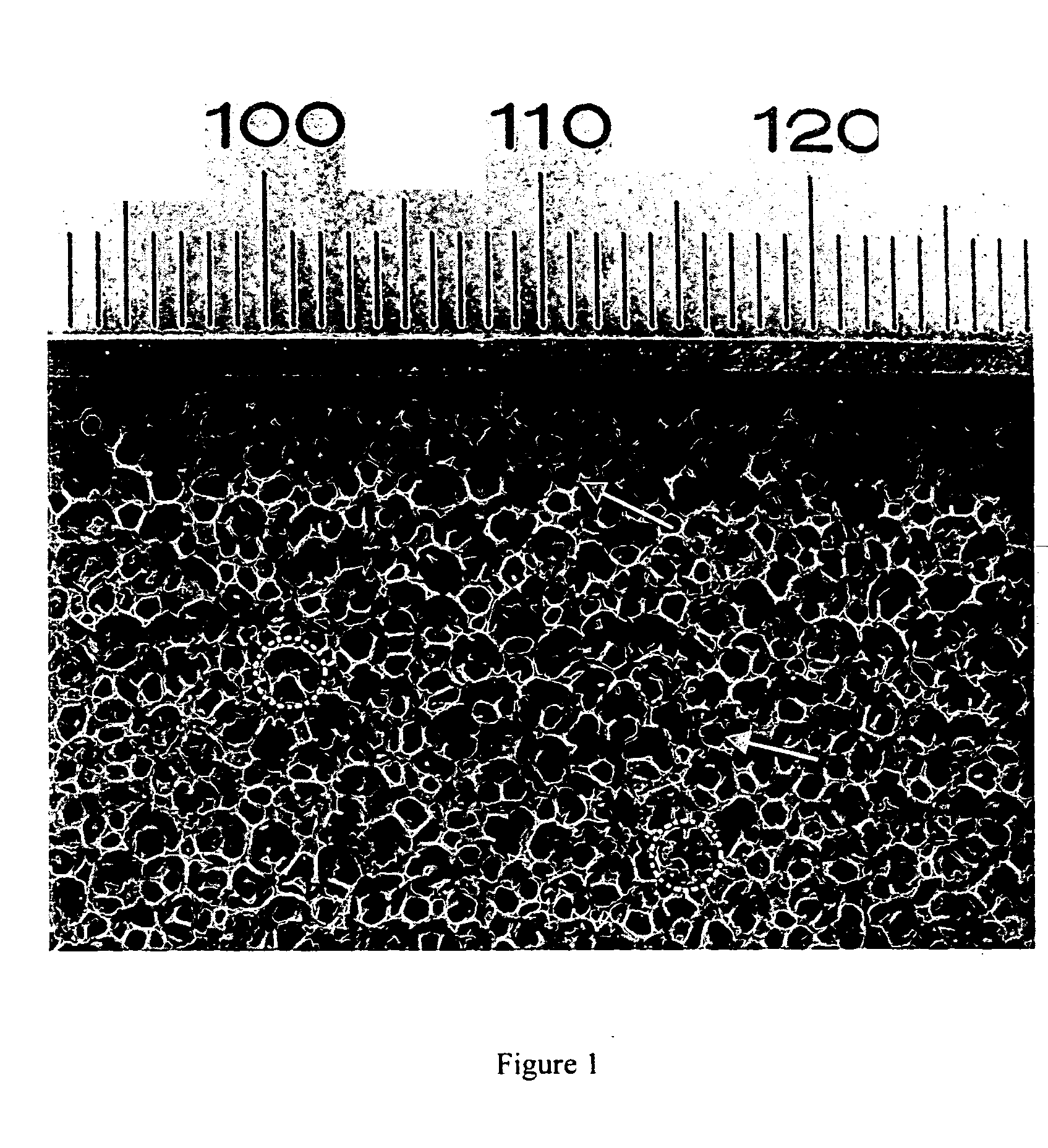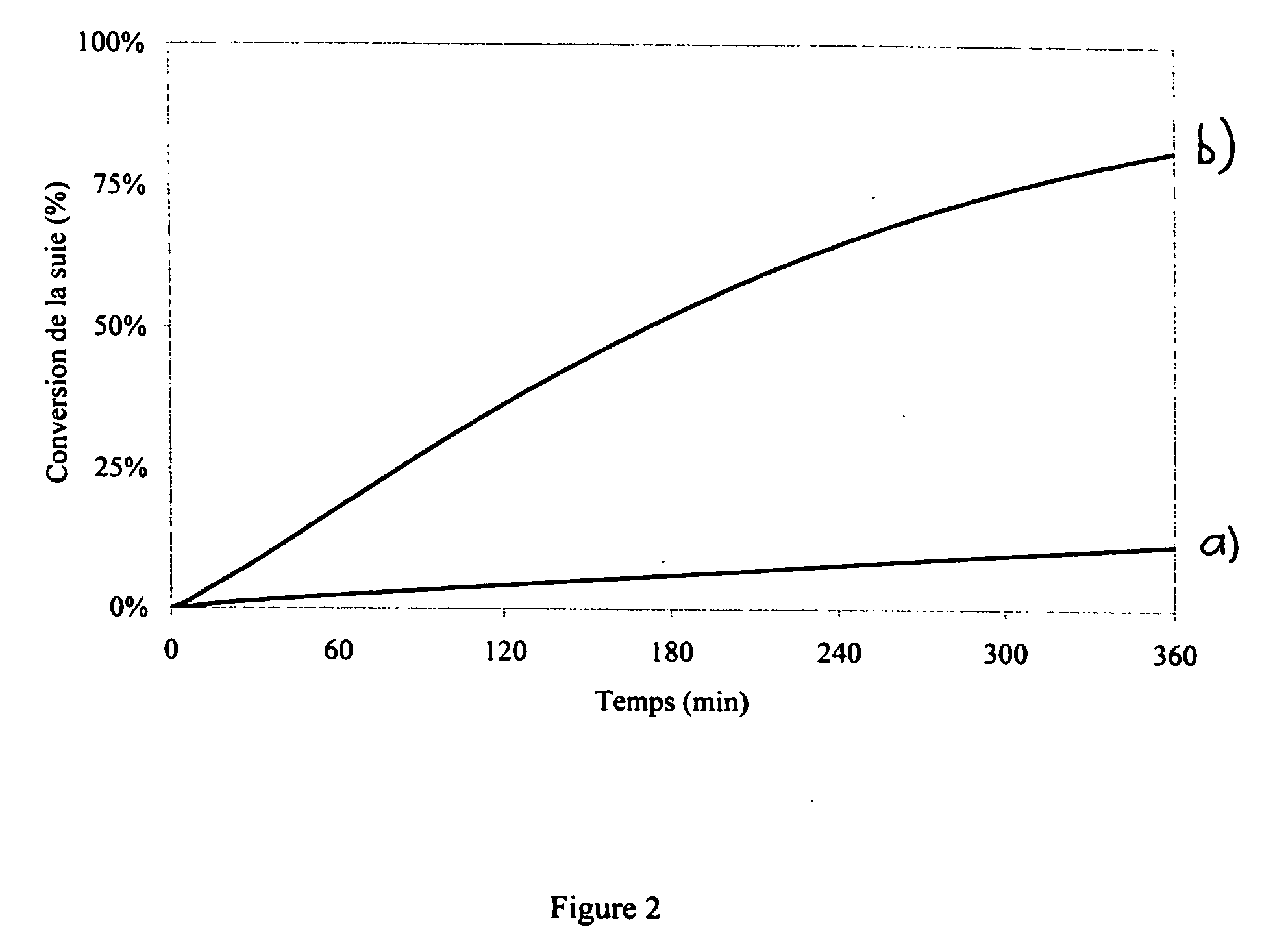Catalytic filter based on silicon carbide (beta-SiC) for combustion of soot derived from exhaust gases from an internal combustion engine
a technology of silicon carbide and catalytic filter, which is applied in the direction of metal/metal-oxide/metal-hydroxide catalyst, machine/engine, chemical/physical process, etc., can solve the problems of reducing lung capacity, reducing the efficiency of combustion, and forming solid particles during combustion, so as to facilitate the recycling of the active phase and save manufacturing costs. , the effect of low manufacturing cos
- Summary
- Abstract
- Description
- Claims
- Application Information
AI Technical Summary
Benefits of technology
Problems solved by technology
Method used
Image
Examples
example 1
Preparation Process for an Active Catalyst Phase for Deposition on a β-Sic Foam
[0126] This example illustrates details of the preparation of a catalyst capable of burning soot output from a diesel engine.
[0127] A homogeneous mix was prepared composed of a suspension of 810 g of silicon powder in 1000 g of phenolic resin. A polyurethane foam based on polyester with an average porosity of 1200 μm was impregnated with this mix, with a quantity equal to about 20 times its own mass. The part obtained was then hardened by a treatment under air at 150° C. for 3 hours, and was then treated at 1360° C. for 1 hour under an argon flow in order to form a β-SiC phase. Finally, the residual carbon was eliminated by heating the foam under air at 700° C. for 3 hours.
[0128] The part thus obtained has an average cellular porosity (macroscopic) of about 1500 μm, which was about 25% more than the size in the initial foam. This cellular porosity was complemented by an additional porosity ranging from ...
example 2
Use of a Catalyst Prepared According to Example 1 in a Soot Combustion Model Study
[0131] This example describes results obtained during combustion of a model soot on a catalytic filter composed of a β-SiC foam with a pore opening of 3600 μm and an active phase containing 0.5% by mass of platinum. The catalytic filter was cylindrical in shape and its dimensions were 30 mm diameter and 20 mm long. Its mass is 1.44 g. Its specific surface area was on the order of 10 m2 / g.
[0132] After impregnation and heat treatment (as described in Example 1), the catalytic filter was impregnated with 5% by mass of dry soot (Printex U, Degussa) by immersion in an ethanol solution containing the soot in suspension. The catalytic filter and soot system was then inserted in a quartz tubular reactor (inside diameter 30 mm, length 800 mm) forming part of a set up designed to evaluate the capacity of the catalytic filter to burn the deposited soot, as a function of the reactor temperature. The test was car...
example 3
Use of Silicon Carbide (β-SiC) Foams with Variable Porosities Catalyzed with Pt Obtained According to Example 1 for Combustion of Soot Particles in Exhaust Gases Output from a Diesel Engine
[0134] This example illustrates the use of a catalytic filter composed of two foams with different cellular pore sizes in the depollution of exhaust gases output from a diesel engine. The objective was to use two foams impregnated with Pt, in which the pore size was varied so that soot particles output from a diesel engine are burned. To achieve this, we prepared two foams (specific surface area about 10 m2 / g), with different cellular pore openings alternately installed to face the exhaust gas inlet in the catalytic filter device: the first had pore openings of 2400 μm, the second 1500 μm. Both were catalyzed with 0.5% by mass of platinum using the method described in Example 1.
[0135] The volume of these 2 foams is 60 mL. This filter system was then placed at the output from the exhaust line of ...
PUM
| Property | Measurement | Unit |
|---|---|---|
| specific surface area | aaaaa | aaaaa |
| specific surface area | aaaaa | aaaaa |
| specific surface area | aaaaa | aaaaa |
Abstract
Description
Claims
Application Information
 Login to View More
Login to View More - R&D
- Intellectual Property
- Life Sciences
- Materials
- Tech Scout
- Unparalleled Data Quality
- Higher Quality Content
- 60% Fewer Hallucinations
Browse by: Latest US Patents, China's latest patents, Technical Efficacy Thesaurus, Application Domain, Technology Topic, Popular Technical Reports.
© 2025 PatSnap. All rights reserved.Legal|Privacy policy|Modern Slavery Act Transparency Statement|Sitemap|About US| Contact US: help@patsnap.com



